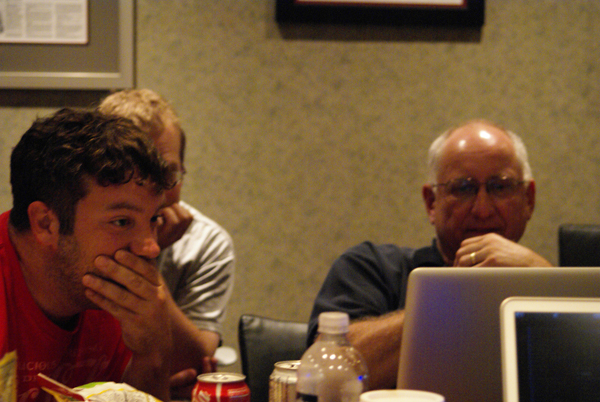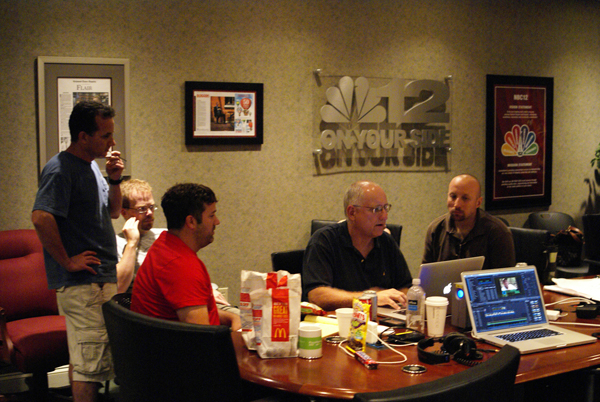48 Hour Film Project, Part 2: Accelerating the Edit in Apple Final Cut Pro X
No matter how fast, efficient, and determined a 48 Hour Film Project production team is, they need to finish strong with a streamlined edit. Final.revised editor Scott Strimple describes how Apple Final Cut Pro X allowed him to deliver the goods on deadline, by leveraging key features that could make any edit cook.
Adding Effects
When the film was ready for some visual effects, such as making an iPod in the film appear to have an active screen, they turned to Victor Nash, their director who hails from Richmond's NBC12 affiliate, for his command of Adobe After Effects.

Victor (left) and Scott (right) editing Foot Patrol
In need of a professional-looking Foot Patrol logo, Michael Crouch, also of NBC12, cranked one out in no time. "Michael is great with graphics. We said we needed a Foot Patrol logo, and the next thing you know you've got gorgeous graphics that come out of nowhere," Strimple says.
Editing Teamwork
The brisk pace of editing was made easier by the fact that the team members "spoke the same language. Everybody there was a participating editor." They understood that "the whole point of the exercise is to tell a story fast," Strimple says, comparing this to "some other films that don't go fast enough and drag on. They may have good production value, but slow pacing. They don't keep the story going." And that's key when you have only 4-7 minutes to tell the story.

The core final.revised production team editing Foot Patrol in Final Cut Pro X
At 6:58 p.m., cutting it a smidge closer than planned, they hopped in the car with the film still spitting out to two USB thumb drives. Twenty-two minutes later they were sitting in the parking lot of the Camel, the local restaurant where contest organizers collected entries, waiting for the download. At 7:21 p.m., just like a scene from a, well, a movie, they rushed in and hand-delivered their package within deadline.
"When you get to The Camel," Strimple explains of the submission process, "Richmond's 48HFP producer Samantha Tucker hands you a Post-it Note with the time on it, and you get in line. You drop your film off with all your paperwork. We got there and there were seven or eight people in line." With a full 48 hours of rapid-fire filmmaking behind them, final.revised gathered for a celebratory drink.
Related Articles
In this first installment of our new tutorial series, Glen Elliott demystifies Final Cut Pro X, illustrates its core functions, and focuses on one of the most powerful new features for organizing, accelerating, and streamlining your edits: metadata keyword tagging.
Background noise and pops and clicks in audio are an unfortunate fact of life for many productions. In this tutorial we'll explore some fixes you can try in Final Cut Pro X.
The histogram and the waveform in Apple Final Cut Pro X are effective, easy-to-master tools that provide the clear input you need to diagnose and fix the contrast issues in your video simply and intelligently. In this video tutorial, video editing and encoding expert Jan Ozer explains how they work.
The 48 Hour Film Project offers filmmakers a chance at fame and glory and unleashed creativity, along with the insanity of producing a film from pre to post in two days. Scott Strimple, editor of award-winning 48HFP entries two years running, recounts what it was like putting together this year's film. In Part 2 he'll discuss the instrumental role Apple Final Cut Pro X played in editing and delivering the film with a cool 9 minutes to spare.